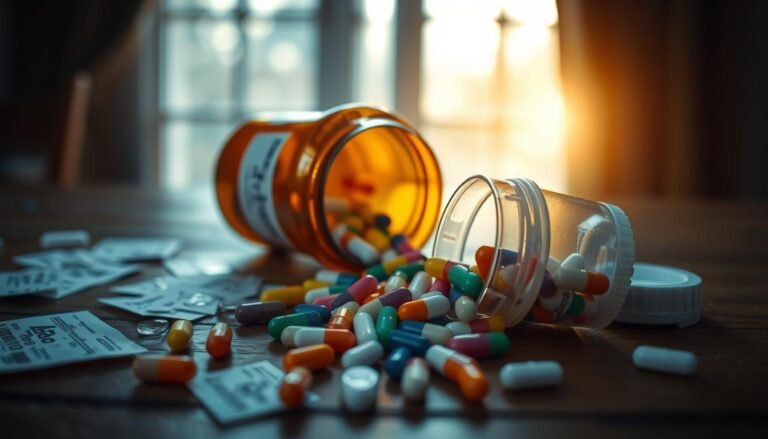Opioid Addiction Support: Strengthening Your Path to Healing
Did you know that 90% of Americans at risk for opioid use disorder don’t receive the help they need? This staggering statistic highlights a critical gap in addiction treatment. Opioid addiction is a chronic but treatable condition, and the field of rehabilitation is constantly evolving to offer better solutions.
Today, recovery plans often combine medical, behavioral, and lifestyle approaches to address the root causes of addiction. Research shows that personalized treatment plans, supported by community resources, can significantly improve outcomes. Staying informed through trusted platforms like addictionhotlinetoday.com, habitrecovery.com, and rehabme.org is essential for understanding the latest advancements.
This article will explore how medication, therapy, and lifestyle changes work together to support recovery. Whether you’re seeking help for yourself or a loved one, there’s hope. Let’s dive into the strategies that can empower you on this journey.
Key Takeaways
- Opioid addiction is a chronic but treatable condition.
- Rehabilitation strategies are constantly evolving.
- Personalized treatment plans improve recovery outcomes.
- Community support plays a vital role in healing.
- Staying informed through trusted resources is crucial.
Understanding Opioid Addiction and Its Challenges
The brain’s reward system plays a central role in how opioid addiction develops and persists. When opioids are used, they flood the brain with dopamine, creating a sense of euphoria. Over time, the brain adapts to this surge, reducing its natural dopamine production. This change makes it harder to feel pleasure without the substance, leading to dependency.
The Science Behind Addiction
Addiction is not a moral failing—it’s a brain disorder. Research from the Journal of Neuroscience shows that prolonged opioid use alters the brain’s structure and function. Dopamine transporters, which regulate mood and motivation, become less effective. This makes it challenging for individuals to stop using opioids, even when they want to.
Studies also reveal that the brain can recover after abstinence. However, this process takes time and often requires medical and behavioral support. Tailored treatment plans, which address both the biological and behavioral aspects of addiction, are essential for long-term recovery.
Common Misconceptions and Realities
One common misconception is that relapse means treatment has failed. In reality, relapse is a common part of the recovery process, much like in other chronic diseases such as diabetes or hypertension. Data from JAMA shows that relapse rates for opioid addiction are comparable to those for asthma or high blood pressure.
Another myth is that addiction is a choice. Science confirms that it’s a complex interplay of genetics, environment, and brain chemistry. Understanding this can reduce stigma and encourage more people to seek help.
For the latest insights and resources, visit addictionhotlinetoday.com. Staying informed is a crucial step in overcoming the challenges of opioid addiction.
Research-Based Principles of Effective Treatment
Modern addiction treatment combines medication and behavioral strategies for lasting results. These methods are grounded in research and tailored to meet the unique needs of each person. By addressing both the physical and emotional aspects of substance use, recovery becomes more attainable.
Medication-Based Therapies
Medications like methadone, buprenorphine, and extended-release naltrexone play a crucial role in treatment. They help reduce cravings and withdrawal symptoms, making it easier for a person to focus on recovery. According to the National Institute on Drug Abuse (NIDA), these medications are most effective when combined with behavioral therapies.
Methadone, for example, stabilizes the body by mimicking opioids without the high. Buprenorphine works similarly but with a lower risk of misuse. Naltrexone blocks opioid effects entirely, helping prevent relapse. These options are part of a comprehensive program designed to support long-term recovery.
Behavioral and Counseling Approaches
Behavioral therapies like Cognitive Behavioral Therapy (CBT) and Motivational Enhancement Therapy (MET) are equally important. CBT helps individuals identify and change negative thought patterns, while MET builds internal motivation for change. These approaches address the mental health challenges often associated with substance use.
Research shows that combining medication with behavioral therapy improves outcomes. For example, a study published in the Journal of Substance Abuse Treatment found that this dual approach reduces relapse rates significantly. Programs that integrate these methods cater to the whole person, promoting both body and mind recovery.
For more information on personalized treatment plans, visit addictionhotlinetoday.com. Staying informed is a vital step in the recovery journey.
Customizing Your opioid-addiction-support-strengthening-your-journey
Every individual’s journey to recovery is unique, requiring tailored strategies for success. No two people experience substance use disorder in the same way, which is why personalized treatment plans are essential. These plans consider factors like the severity of the disorder, stress levels, and even brain chemistry to create a roadmap for healing.
Tailoring Treatment to Individual Needs
Personalized treatment begins with understanding the individual. Factors like the severity of substance use disorder, stress triggers, and life circumstances play a significant role. For example, someone with a high-stress job may need additional coping strategies, while another person might benefit from addressing underlying mental health issues.
Research shows that the brain’s response to substances like alcohol varies widely. This variability means that treatment must be adaptable. A study published in the Journal of Neuroscience highlights how personalized approaches can improve recovery outcomes by addressing these differences.
Integrating Medical and Behavioral Insights
Effective recovery plans combine medical and behavioral insights. Medications like buprenorphine can help manage cravings, while therapies like Cognitive Behavioral Therapy (CBT) address thought patterns that contribute to substance use. This dual approach ensures both the body and mind are supported.
For instance, a person with a history of alcohol use might benefit from naltrexone, which blocks the effects of alcohol. Pairing this with behavioral therapy can reduce relapse rates and improve overall life quality. According to the Johns Hopkins Medicine, integrating these methods is key to long-term success.
- Personalized treatment strategies address unique patient profiles.
- Tailored plans consider factors like stress levels and brain chemistry.
- Integrating medical and behavioral insights creates a cohesive recovery plan.
- Customized therapy improves life quality and reduces relapse risks.
Real-life examples show the power of personalized treatment. One individual, struggling with substance use disorder and high stress, found success through a tailored plan that included stress management techniques and medication. Their recovery journey highlights the importance of adapting treatment to fit individual needs.
For more personalized support, visit rehabme.org. Their resources can help you or a loved one take the next step toward recovery.
Integrating Exercise into Addiction Recovery
Exercise is a powerful tool in the recovery process, offering both physical and mental benefits. It helps individuals manage cravings, improve overall health, and build resilience. Research shows that regular physical activity can significantly enhance recovery outcomes.
Physical Benefits of Regular Activity
Regular exercise improves cardiovascular health and strengthens the body. It helps repair damage caused by substance use disorder, such as muscle weakness and poor bone density. Strength training and aerobic exercises are particularly effective.
Studies indicate that exercise can reduce withdrawal symptoms like anxiety and depression. It also promotes better sleep, which is crucial for recovery. For more tips on physical activities, visit your path to opioid recovery.
Mental Health Advantages Through Movement
Exercise releases endorphins, which boost mood and reduce stress. It serves as a constructive way to distract from cravings and build mental resilience. Activities like yoga and mindfulness practices enhance focus and emotional stability.
Research shows that exercise can improve self-esteem and confidence. It also fosters social connections, especially in group fitness classes. These benefits make exercise a vital part of any recovery plan.
| Exercise Type | Physical Benefits | Mental Benefits |
|---|---|---|
| Running | Improves cardiovascular health | Reduces stress and anxiety |
| Yoga | Enhances flexibility and strength | Promotes mindfulness and focus |
| Swimming | Builds endurance and muscle tone | Boosts mood and relaxation |
| Strength Training | Increases muscle mass and bone density | Improves self-esteem and discipline |
Incorporating exercise into your recovery plan can make a significant difference. Start with activities you enjoy and gradually increase intensity. Remember, consistency is key to reaping the benefits.
Balancing Medication, Therapy, and Exercise for Long-Term Recovery
Achieving long-term recovery requires a balanced approach that combines medication, therapy, and exercise. Each part of this triad plays a crucial role in addressing the physical, emotional, and behavioral aspects of addiction. Together, they create a powerful foundation for sustained healing.
Managing Withdrawal and Preventing Relapse
Managing withdrawal symptoms is a critical thing in the early stages of recovery. Medications like buprenorphine and naltrexone help reduce cravings and stabilize the body. Behavioral therapies, such as Cognitive Behavioral Therapy (CBT), address the mental health challenges that often accompany addiction.
Exercise also plays a vital role. Regular physical activity reduces stress and anxiety, which are common triggers for relapse. Studies show that individuals who incorporate exercise into their recovery plan are less likely to experience relapse at any level of intensity.
Creating a Comprehensive Recovery Plan
A well-rounded recovery plan integrates medication, therapy, and exercise. Each type of intervention complements the others, creating a holistic approach to healing. For example, medication manages physical symptoms, therapy addresses emotional challenges, and exercise builds resilience.
Here’s a breakdown of how each part contributes to recovery:
| Intervention | Benefits |
|---|---|
| Medication | Reduces cravings, manages withdrawal symptoms |
| Therapy | Addresses emotional and behavioral challenges |
| Exercise | Reduces stress, improves mood, builds resilience |
Creating a personalized plan is essential. Start by consulting a healthcare provider to determine the right type of medication and therapy for your needs. Then, incorporate exercise routines that fit your lifestyle. Consistency is key to reaping the long-term effect of these interventions.
For more strategies on managing withdrawal and preventing relapse, visit addictionhotlinetoday.com. Their resources can help you stay on track and achieve your recovery goals.
Navigating the Changing Landscape of Addiction Information
The digital age has transformed how we access and use addiction information. With new research and treatment strategies emerging regularly, staying informed is essential for effective recovery. Reliable resources can help you adapt your recovery plan to the latest advancements.

Leading Online Resources and Hotlines
Reputable platforms like rehabme.org, addictionhotlinetoday.com, and habitrecovery.com provide up-to-date research and data on addiction treatment. These sites offer tools to manage withdrawal symptoms, reduce anxiety, and track progress in the recovery process.
Hotlines are another valuable resource. They provide immediate support and guidance, especially during challenging moments. Whether you’re seeking help for yourself or a loved one, these services are a lifeline.
Staying Informed with Recent Research
Recent breakthroughs in addiction treatment emphasize the importance of personalized care. For example, new guidelines on managing withdrawal and anxiety have improved outcomes for many individuals. Staying updated ensures your treatment plan remains effective.
Innovations like telehealth sessions and digital therapy tools are also transforming the recovery landscape. These advancements make it easier to access care, even from the comfort of your home.
To stay informed, visit trusted resources like addictionhotlinetoday.com. Their insights can help you navigate the complexities of addiction and recovery.
Addressing Risks: Exercise, Relapse, and Recovery
Exercise can be a game-changer in recovery, but it’s essential to approach it with caution. While physical activity offers numerous benefits, it also carries risks if not balanced properly. Overexertion or improper routines can lead to injuries, depression, or even relapse. Understanding these pitfalls is key to making exercise a safe and effective part of your recovery plan.
Identifying Potential Pitfalls in Exercise Routines
Starting an exercise routine during recovery can be challenging. Overdoing it can strain the heart and body, leading to fatigue or injury. Studies show that excessive exercise can trigger depression or anxiety, especially in individuals recovering from drug use. It’s crucial to monitor your body’s signals and avoid pushing too hard.
Another risk is replacing one habit with another. Exercise addiction, though rare, can develop if physical activity becomes compulsive. This can undermine recovery efforts and create new challenges. To avoid this, set realistic goals and maintain a balanced approach.
Best Practices in Avoiding Relapse Triggers
Exercise can sometimes trigger relapse if not managed carefully. High-intensity workouts may increase stress levels, which can be a risk factor for returning to drug use. To mitigate this, focus on moderate activities like walking, yoga, or swimming. These are gentler on the body and mind.
Working with a healthcare professional is essential. They can help tailor an exercise plan that supports your recovery without overburdening your system. Regular check-ins ensure you’re on track and can adjust as needed.
| Best Practice | Benefit |
|---|---|
| Start with low-intensity exercises | Reduces strain on the body and mind |
| Monitor for signs of overexertion | Prevents injuries and relapse triggers |
| Set realistic fitness goals | Encourages consistency and progress |
| Incorporate mindfulness practices | Enhances mental well-being |
For more guidance on integrating exercise into your recovery plan, visit addiction support resources. Staying informed and connected with your community can make all the difference in your journey.
Fostering a Supportive Community and Lifestyle Changes
Building a strong community can transform the recovery process, offering both emotional and practical support. A supportive network helps individuals feel less isolated and more motivated to stay on track. Combining lifestyle changes with this network creates a foundation for long-term success.

Building a Network for Sustained Sobriety
Creating a supportive group is essential for recovery. Peer support groups, like those at habitrecovery.com, provide a safe space to share experiences and challenges. These groups foster connections with others who understand the journey, reducing feelings of loneliness.
Regular activity, such as group exercise or volunteering, strengthens these bonds. Studies show that individuals with strong social networks are more likely to maintain sobriety. Engaging in shared goals, like fitness classes or community projects, builds trust and accountability.
Embracing Mindfulness and Self-Care Strategies
Mindfulness practices, such as meditation or yoga, help manage stress and cravings. These techniques encourage focus on the present moment, reducing anxiety. Incorporating self-care routines, like journaling or relaxation exercises, supports emotional well-being.
During the recovery stage, it’s important to prioritize mental health. Research indicates that mindfulness can lower relapse rates by improving emotional resilience. Combining these practices with regular exercise creates a balanced approach to healing.
| Strategy | Benefit |
|---|---|
| Join support groups | Reduces isolation, builds accountability |
| Engage in group activities | Strengthens social connections |
| Practice mindfulness | Manages stress and cravings |
| Incorporate self-care | Supports emotional well-being |
For more resources on building a supportive community, visit habitrecovery.com. Their programs can help you create a network that empowers your recovery journey.
Conclusion
Recovery from substance use is a journey that thrives on a well-rounded approach. Combining medication, therapy, and regular exercise creates a powerful foundation for healing. Each element addresses different aspects of recovery, from managing cravings to building emotional resilience.
Staying informed and connected is crucial. Reputable resources like support groups provide valuable guidance and community. These platforms offer tools and insights to help you navigate challenges and stay on track.
Remember, recovery is a continuous process. Personalized care and a strong support system can make all the difference. By integrating medical, behavioral, and lifestyle strategies, you can achieve long-term benefits and improve your quality of life.
Take the next step in your journey. Explore trusted resources and connect with professionals who can guide you toward a healthier, brighter future.






